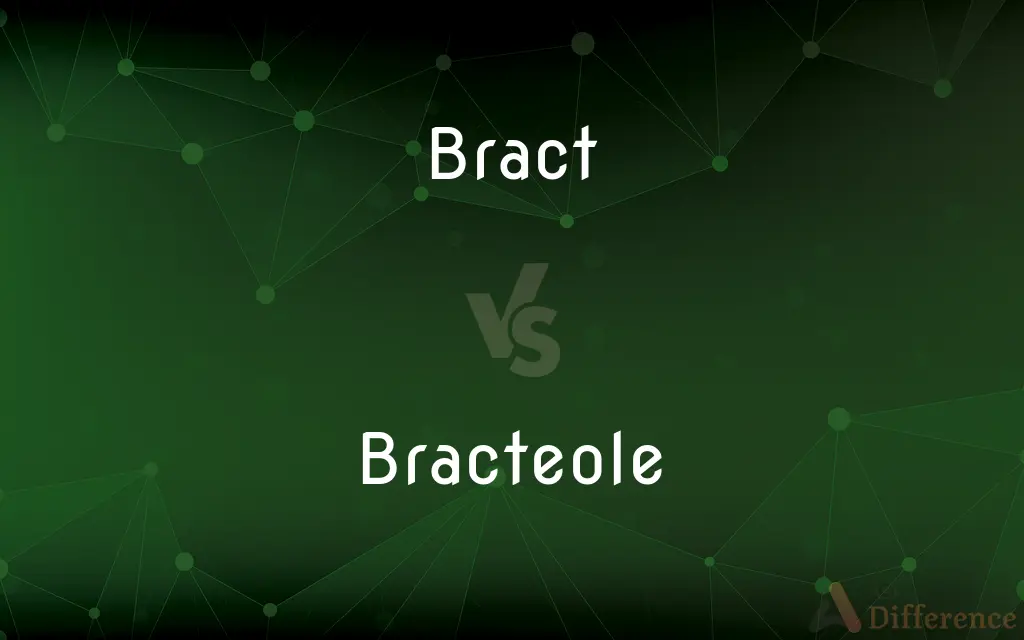Bract vs. Bracteole — What's the Difference?
Edited by Tayyaba Rehman — By Maham Liaqat — Updated on April 1, 2024
Bracts are modified leaves associated with a flower, while bracteoles are smaller, secondary bracts found on a flower's pedicel.

Difference Between Bract and Bracteole
Table of Contents
ADVERTISEMENT
Key Differences
Bracts are modified leaves that are often found just below a flower or flower cluster, playing a role in the attraction of pollinators by their color and shape. Whereas, bracteoles are smaller, often leaf-like structures that are located closer to the flowers themselves, usually on the pedicel, serving similar but more localized functions.
While bracts can be large and colorful, acting as a visual attractant to pollinators (for example, the red bracts of a poinsettia), bracteoles tend to be smaller and less conspicuous, providing more subtle support and protection to the developing flowers.
Bracts are usually found at the base of the flower or flower cluster, sometimes taking on the appearance of petals. On the other hand, bracteoles are positioned closer to individual flowers, sometimes encasing the flower buds before they bloom.
In some plants, bracts are a prominent feature of the flower, significantly contributing to the plant's overall appearance and attractiveness. Conversely, bracteoles are often overlooked due to their smaller size and less prominent positioning.
Bracts have a wide range of functions including attracting pollinators, protecting young flowers, and supporting reproductive processes. Whereas bracteoles generally have a more limited scope of function, often related to the protection and support of the flower bud.
ADVERTISEMENT
Comparison Chart
Location
Below the flower or flower cluster
On the pedicel closer to the flower
Size
Larger
Smaller
Function
Attract pollinators, protect flowers
Support and protect flower buds
Visibility
Often colorful and prominent
Less conspicuous
Role in Attraction
Can act as pseudo-petals
More subtle, supporting role
Compare with Definitions
Bract
Bracts can be deciduous or persistent, varying widely among species.
The persistent bracts of some plant species remain attached well after flowering.
Bracteole
They may assist in the mechanical support of flowers, especially in windy environments.
Bracteoles can stiffen, providing stability to flowers exposed to strong winds.
Bract
Protective in nature, bracts shield developing buds from environmental stresses.
In some species, bracts fold over buds, protecting them from harsh weather.
Bracteole
Often subtler than bracts, bracteoles play a supporting role in flower development.
The bracteoles of many flowers are critical in the early stages of bud formation.
Bract
In some plants, bracts play a structural role, supporting flowers or inflorescences.
The sturdy bracts of corn support the tassels and ears as they develop.
Bracteole
Like bracts, bracteoles may persist on the plant after flowering, contributing to seed dispersion.
Persistent bracteoles can aid in the wind dispersal of seeds by catching the breeze.
Bract
Bracts can serve to attract pollinators with their vivid colors and shapes.
The large bracts of some plants are crucial in attracting bees for pollination.
Bracteole
Bracteoles can be highly specialized, varying greatly among different plant species.
In some species, bracteoles have evolved to secrete substances that deter predators.
Bract
A modified leaf associated with a flower or flower cluster, often colorful and large.
The bright red bracts of the poinsettia are commonly mistaken for petals.
Bracteole
A smaller, secondary bract found on the pedicel of a flower.
Bracteoles encase the developing flower bud of the hibiscus, offering protection.
Bract
In botany, a bract is a modified or specialized leaf, especially one associated with a reproductive structure such as a flower, inflorescence axis or cone scale. Bracts are often (but not always) different from foliage leaves.
Bracteole
A small bract.
Bract
A leaflike or scalelike plant part, usually small, sometimes showy or brightly colored, and located just below a flower, a flower stalk, or an inflorescence.
Bracteole
(botany) A small leaf of leaf-like structure directly subtending a flower or inflorescence whose stalk itself is subtended by a bract.
Bract
(botany) A leaf or leaf-like structure from the axil out of which a stalk of a flower or an inflorescence arises.
Bracteole
(botany) A bract subtending an individual flower rather than an inflorescence.
Bract
A leaf, usually smaller than the true leaves of a plant, from the axil of which a flower stalk arises.
Bracteole
Same as Bractlet.
Bract
A modified leaf or leaflike part just below and protecting an inflorescence
Bracteole
A small bract
Common Curiosities
Can bracts and bracteoles perform similar functions?
Yes, both can serve to attract pollinators and protect the flowers, though bracts are often more visible and prominent.
What is a bract?
A bract is a modified leaf associated with a flower or flower cluster, often serving to attract pollinators or protect budding flowers.
How do bracteoles differ from bracts?
Bracteoles are smaller, secondary bracts located closer to the flowers on the pedicel, usually serving more localized functions such as supporting and protecting flower buds.
Are bracteoles always smaller than bracts?
Typically, yes, bracteoles are smaller and located closer to the flowers than the more prominent bracts.
Can bracteoles be colorful?
While bracteoles are generally less conspicuous than bracts, they can still be colorful in some species.
Do all flowers have bracts and bracteoles?
Not all flowers have bracts and bracteoles; their presence and prominence vary widely among different plant species.
What role do bracteoles play in flower development?
Bracteoles primarily support and protect the developing flower bud, sometimes also assisting in mechanical support.
Do bracts mimic petals?
In some plants, bracts are colorful and large, mimicking petals to attract pollinators.
How do bracts and bracteoles contribute to a plant's reproduction?
They can both contribute to attracting pollinators, protecting developing flowers, and supporting the plant's reproductive processes.
Are bracts always located at the base of the flower?
Bracts are typically located at the base of a flower or flower cluster, but their exact position can vary among species.
Do bracteoles remain on the plant after flowering?
In many cases, bracteoles persist on the plant, potentially contributing to seed dispersal mechanisms.
Can the presence of bracts and bracteoles be used to identify plant species?
Yes, the presence, size, shape, and color of bracts and bracteoles can be key identifiers for specific plant species.
Share Your Discovery

Previous Comparison
Outsourcer vs. Outsource
Next Comparison
Arms vs. HandAuthor Spotlight
Written by
Maham LiaqatEdited by
Tayyaba RehmanTayyaba Rehman is a distinguished writer, currently serving as a primary contributor to askdifference.com. As a researcher in semantics and etymology, Tayyaba's passion for the complexity of languages and their distinctions has found a perfect home on the platform. Tayyaba delves into the intricacies of language, distinguishing between commonly confused words and phrases, thereby providing clarity for readers worldwide.
















































